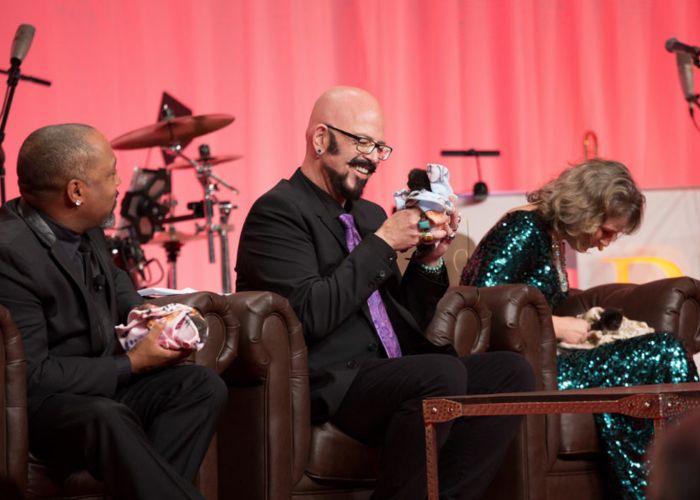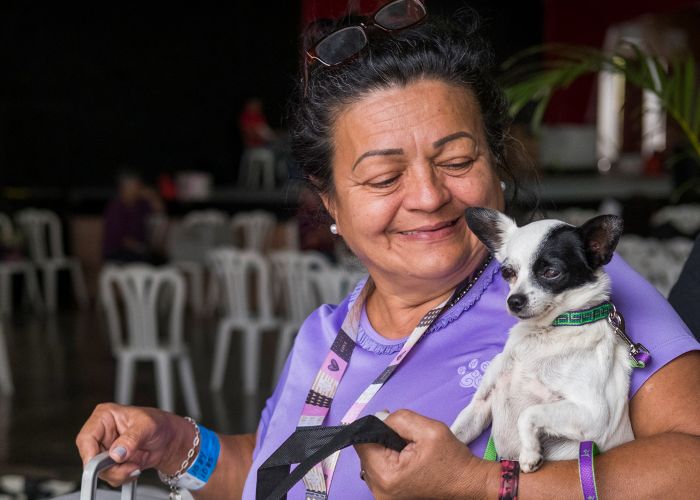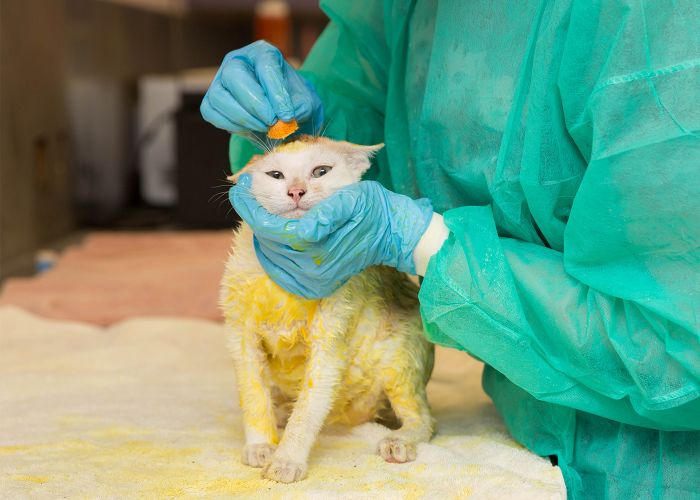Better together
Innovative house call program helps elderly New Yorkers keep their pets
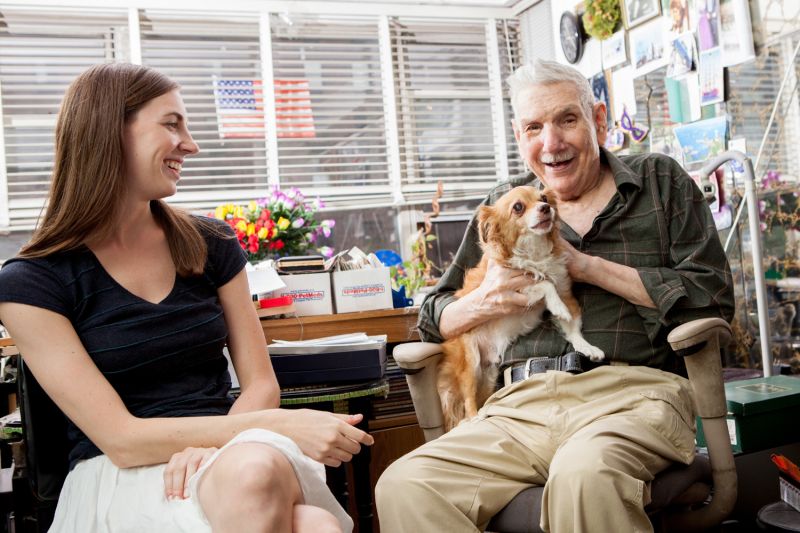
The first time he stepped foot in an animal shelter, Arnold Johnston was a 73-year-old widower, struggling with grief and loneliness. He needed somebody to love.
He and his wife had often talked about adopting a dog, but it never seemed like the right time. For most of their marriage, Johnston worked for the U.S. Merchant Marine and was gone from home for long stretches. They lived in a small apartment in Manhattan. But the couple, who never had children, liked to imagine their future pet all the same.
They would get a dog once they retired, his wife would often tell him. “And he’ll be so precious,” she would say, “I’m going to name him after a precious stone: Jade.”
His wife didn’t live long enough to see it happen, but three years after her death, Johnston was at the animal shelter, studying a gold-and-white Chihuahua mix. When the little dog peered out of the cage to look back at him, Johnston knew he’d found his Jade.
It’s “usually a girl’s name,” he admits, “but Jade is pretty enough to be a girl. He had his name long before he even existed.”
That first meeting was in May 2001, when Johnston was a spry septuagenarian who loved working in the community garden and Jade was a lively 5-month-old who would stand on his hind legs and pirouette for a treat.
The pair’s bond deepened over the years, but by the time he reached his 80s, Johnston’s mobility began to decline. Sometimes he wasn’t able to take Jade outside for exercise and bathroom breaks, especially when the elevator in his apartment building wasn’t working. Simple tasks like bending down to fill food and water bowls had become a challenge. In his darkest moments, he thought that he might have to give up the companion whom he cared for “like he’s my own son.”
Thanks to an innovative program that harnesses the compassion of a small army of New Yorkers, he never had to make that decision.
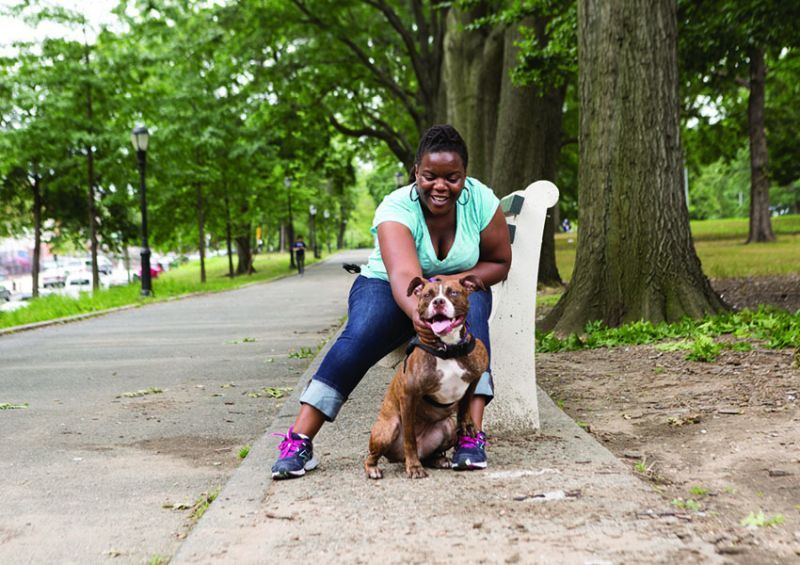
A different kind of social service
Being forced to part with a beloved pet is a legitimate fear for seniors who are struggling to meet their animal’s daily care needs and can’t afford to pay for dog walking or other pet-related services, says Rachel Herman, executive director of PAWS NY in New York City.
In urban areas like New York, where many apartments are walkups, exercising their dog can be a particular challenge for seniors, Herman adds. “They got their pets when they were healthier and younger. Now it’s hard for them to get outside and walk their dog. And they’re putting themselves at risk to do it.”
Herman was in graduate school and volunteering at a private shelter in Manhattan when she started thinking about the plight of vulnerable pet owners. Later, when she was working for the ASPCA, she noticed that a lot of the owner-surrendered animals at the municipal shelters came from elderly guardians. “You had people who didn’t want to give up their pet but felt they had no other choice,” she says. “It was heartbreaking.”
The problem preyed on her mind, and in 2008, after a lot of research and planning, she founded PAWS (Pets Are Wonderful Support) NY as an all-volunteer organization. The next year, she and a handful of other volunteers launched a house call program and worked with Citymeals on Wheels to identify seniors who needed hands-on pet care assistance.
The nonprofit has since grown to include three full-time staffers, including Herman, and programs that provide veterinary care assistance, emergency foster care, pet food and house calls to about 250 low-income senior or disabled people and 400 pets each week.
House calls remain the group’s core program and take the lion’s share of its energies, says Herman. Every day, during holidays and bad weather alike, hundreds of volunteers show up at homes throughout the city to scoop litter boxes, administer pet medications, fill water bowls and take pups on strolls. Sometimes they deliver bags of pet food or transport animals to a veterinarian or grooming salon.
It all contributes to happier, healthier pets and fewer animals surrendered to shelters, but the impact on the owners is equally profound, says Carrie Finch, PAWS NY program director. Even before any services have been rendered, Finch sees the effect during her intake meetings with clients. “The sense of relief that they have is palpable,” she says. “They know that their pet needs more. They know their dog needs more walks; they just physically can’t.”
A licensed social worker who previously worked for a drug addiction program in Harlem, Finch is no stranger to the emotional struggles people can face, but she was still shocked to see how “amazingly isolated” most of her PAWS NY clients are. Many are homebound, she says, and their pet is often their only family and their only regular companionship.
“If you ask them about their support networks, the majority don’t feel like they have one person they can call to help with their pets. ... They don’t have anyone to put down in case of an emergency. They might have a social worker or case manager or home health aide, but those agencies don’t do pet care. It makes our services even more vital because we don’t want them to be separated” from their pet.
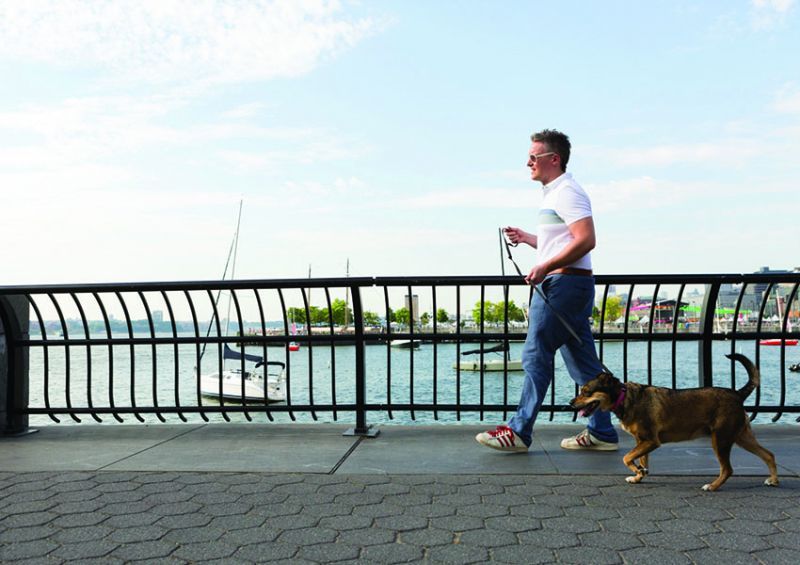
More than a visit
While more and more animal organizations are launching surrender prevention programs to help keep pets in their homes and out of shelters, PAWS NY’s house call program is unusual in the level of ongoing direct care it provides for people’s pets. It’s not a traditional role for an animal welfare organization or a human services nonprofit, which is why Herman describes the group as a “hybrid.” The organization’s tagline—“Helping people by helping pets”—reflects that dual focus.
In the beginning, being a hybrid created some challenges. One of the biggest obstacles to launching the house call program was getting insurance, Herman says. Companies that were accustomed to insuring animal shelters and rescue groups didn’t know what to do with a program that puts volunteers in people’s homes day after day. She ended up purchasing insurance designed for independent pet sitters, and only after a couple of years, when the organization had a history, was she able to get better coverage.
Getting grant funds wasn’t easy, either. For foundations that fund animal welfare, PAWS NY seemed too focused on human needs, and for foundations that support human services, the nonprofit appeared too animal-centered. As Herman puts it: “We’re not providing food or shelter to people. For animals, we’re not [primarily] fostering or rescuing.” It took time for her to identify foundations that “get what we’re doing” and want to help fund it.
But the holistic approach has also had benefits. PAWS NY has a vast referral network that encompasses both animal welfare and human service providers throughout the city, and when people need services outside what its programs can provide, Herman and her team know whom to contact. Nonprofits with spay/neuter and pet wellness clinics often help with the vetting of clients’ animals, while social service case managers can provide useful information on clients and help troubleshoot any problems that arise.
Nearly all house call clients are referred by human welfare organizations, whose staffers quickly recognize the benefits to their clients. When dogs are getting outside to use the bathroom and cats are using their (regularly scooped) litter boxes, it creates a more sanitary home environment. Volunteers also provide more frequent monitoring of vulnerable people.
“Our clients all have different needs, and many of them are dealing with difficult life circumstances, including physical and mental illness,” says Herman. “Because we’re in [clients’ homes] so often, more often than anyone else is, we learn about things no one else does.”
Herman remembers a time several years ago when a volunteer showed up at an elderly client’s home and no one answered the door. The volunteer was eventually able to get the building supervisor to unlock the apartment. They discovered that the man had suffered a stroke; he’d been lying on his bed for hours, unable to move, with his dog Roscoe on the bed beside him. The volunteer called 911, and Herman and her team found a foster home for Roscoe.
“I started this organization to help people keep their pets, but there’s this added layer of responsibility we have,” says Herman. “If our volunteer hadn’t been there, how long would it have been before somebody tried to go there?”
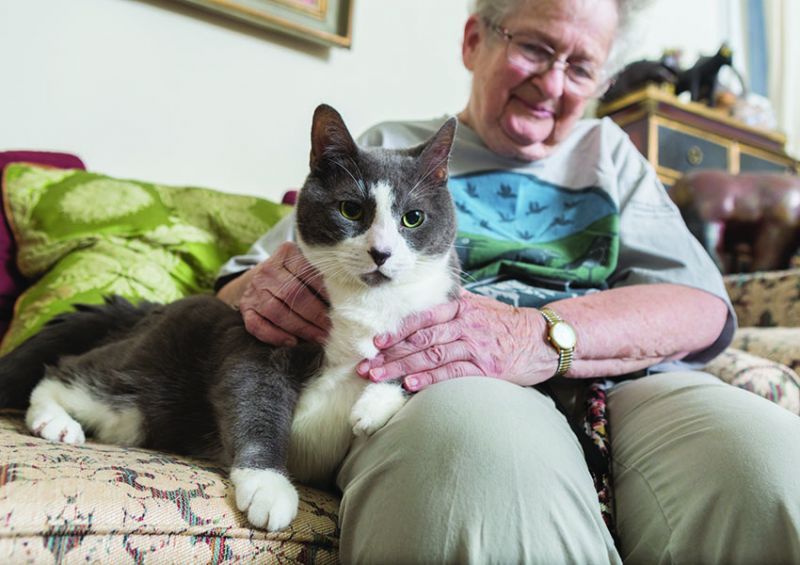
Long-term commitment
Providing daily direct care services requires a lot of coordination and hundreds of dedicated animal lovers. For each new potential client, Finch will first visit the home to assess the person’s and pet’s needs. If there’s a dog involved, she’ll take the pup on a walk to judge his personality and leash manners.
While some clients need just a few visits a week, a single homebound person with a dog will typically require at least two visits a day, which translates to 14 volunteer shifts that the PAWS NY team must schedule and fill each week. One client may be served by as many as 10 volunteers.
The group currently counts over 1,500 volunteers (although not all are active) and holds volunteer orientations and training workshops twice a month. Because of the nature of the work and the population being served, volunteers must pass a background check and provide references. “It’s not just you get to walk a dog, and it’s a beautiful spring day …” says Herman. “You’re working with vulnerable populations and people not in good health.”
Many volunteers are professionals in their 20s and 30s who, because of housing restrictions or busy work schedules, aren’t able to have their own pets. Love for animals is their main motivation, but volunteers often end up forming strong bonds with their human clients.
“It’s an interesting byproduct,” Finch says of these relationships. “We weren’t expecting it, but the volunteers provide so much for the client as well in terms of companionship. Clients tell me it’s so nice to have people visiting, these young people from different walks of life. It enriches their life beyond pet care.”
Because nearly all of their clients are elderly (currently, the oldest is a 100-year-old woman with a rescue dog), the PAWS NY team views every person they serve as a long-term commitment. With a few exceptions, clients don’t become healthier and more mobile over time; instead, their needs tend to increase.
Three years ago, the organization began providing house calls for a 74-year-old blind woman and her service dog, Bella. At the time, the woman was able to take Bella outside regularly, but she couldn’t provide her any off-duty time. To fill that need, volunteers took the dog on three “big fun walks” a week, says Finch.
Last year, as the woman’s health deteriorated, she evolved into a two-walks-a-day client. She’s been hospitalized several times, for stretches as long as 10 weeks, but thanks to PAWS NY’s foster volunteers, she’s never been parted for too long from the dog with whom she shares “an extraordinarily strong bond,” says Finch.
Knowing that someone will care for their pets in an emergency brings clients a lot of peace of mind, she adds. “One of the first things [clients] ask me is, ‘What happens if something happens to me?’”
The commitment continues even if a client dies or moves to a nursing home, Finch says. “We’ve been able to find great homes for every pet we’ve needed one for.”
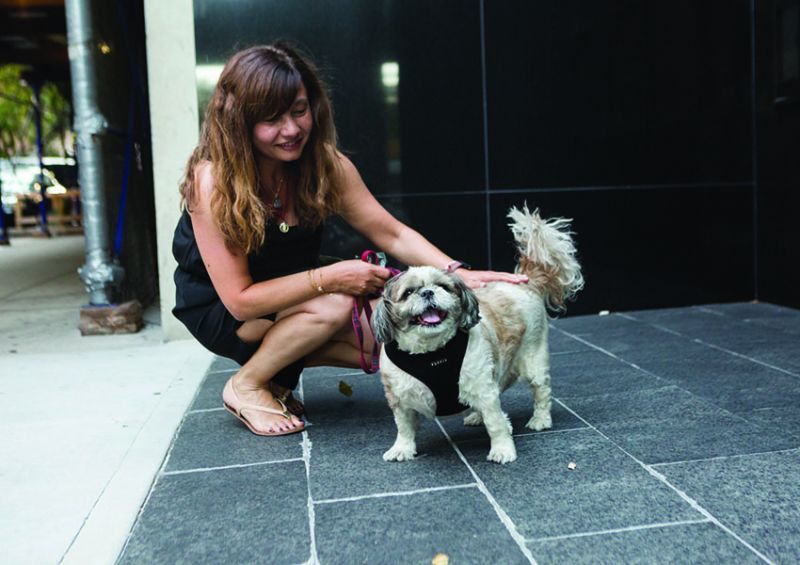
In good company
In the 10 years since Herman first conceived of PAWS NY, the organization has grown in ways she never predicted. “I saw a need and I wanted to make a difference, but I was more in the moment of it rather than thinking about the longer term goals and commitment of it,” she admits. “I was so focused on each day, providing help to the people who are in the program today, I wasn’t thinking about it from this big picture.”
It’s still a tiny nonprofit, but now that it’s more established, Herman is able to focus more on the future. For starters, she’d like to grow the organization’s capacity and increase its impact in all of the city’s boroughs. She wants to expand the emergency foster care program to accommodate more animals: “Our demographic, they will refuse to go into the hospital because they have no one to care for their pets,” she says. And she’d like to help nonprofits in other cities launch similar programs.
At the same time, she is careful not to overextend, because she never wants to shortchange current clients—like Johnston and his dog Jade, who have been with the organization since 2010.
“He and I are both old-timers,” says Johnston, who is now 90.
Jade recently turned 17, and his days of pirouetting for treats are long past. “There’s not much dancing left in him now,” Johnston says, adding with a wry chuckle: “I don’t do much dancing either.”
Twice a day, volunteers come to his eighth-floor apartment to take Jade for a walk. They also help feed him, keep his water bowl full and sometimes transport him to the veterinarian.
Johnston still misses his wife every day, he says, but is grateful for the little dog who has “done the best he can” to fill the void. He’s also grateful for the program that has enabled them to stay together. “They’re all such nice people,” he says of the volunteers who show up each week. “I couldn’t think of living without it, without the PAWS people, and of course, without Jade.”
A decade ago, he worried about being parted from his dog. Now he thinks about a neighbor’s Chihuahua who lived to be 20. He hopes that Jade might surpass even that.



